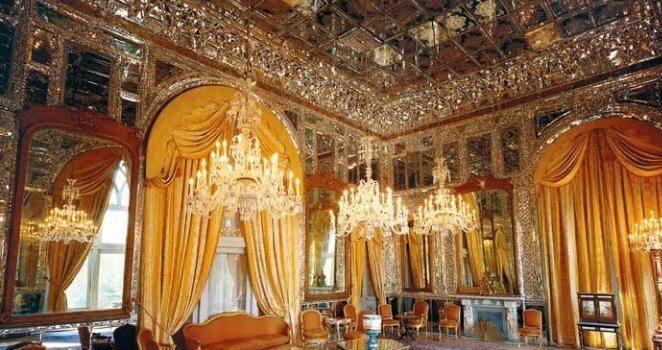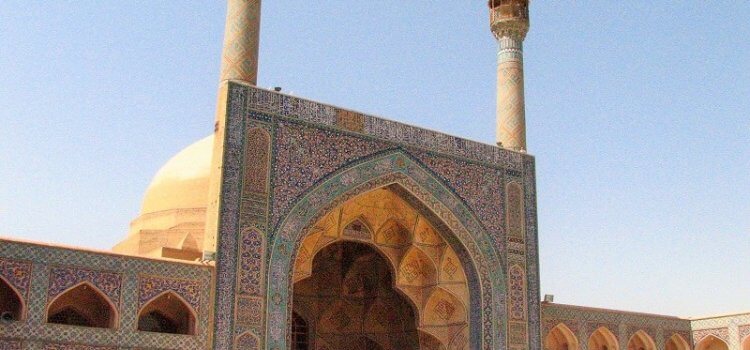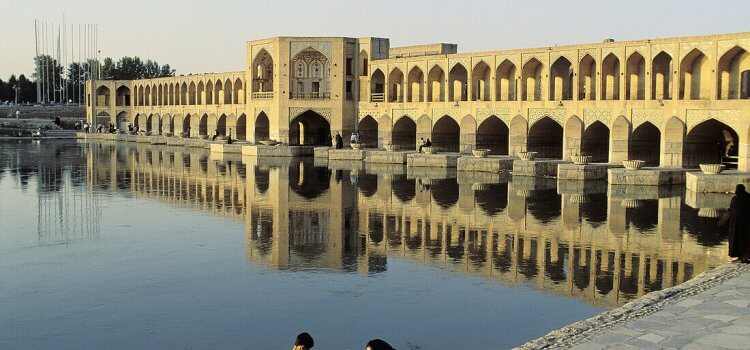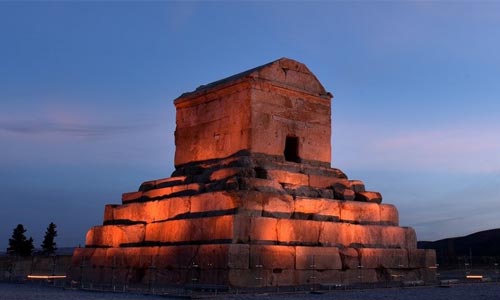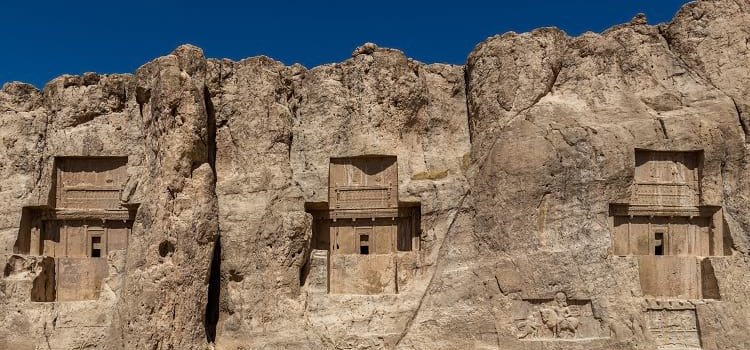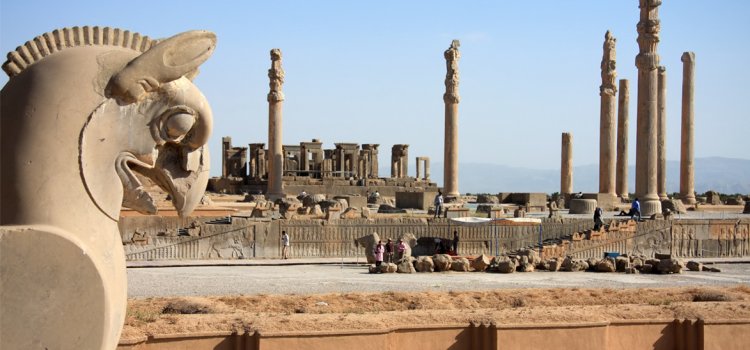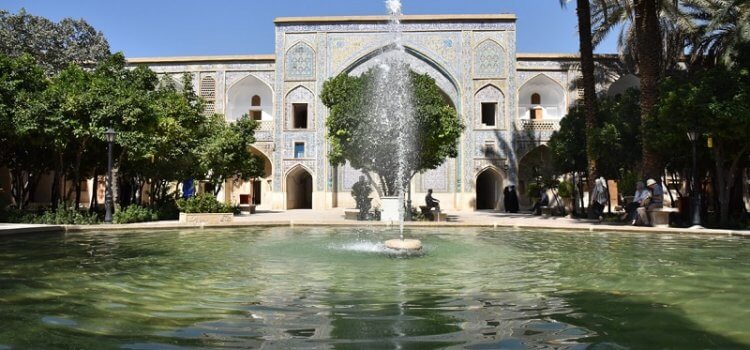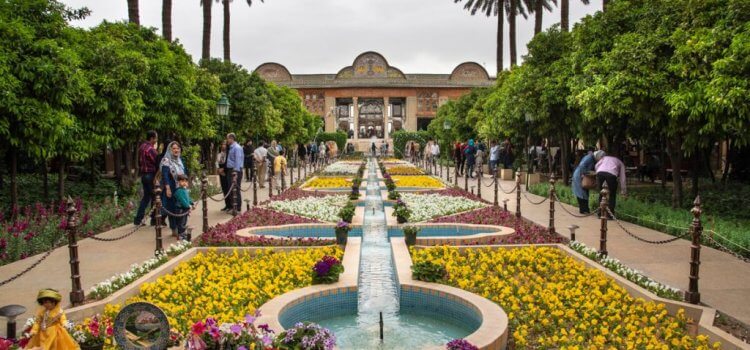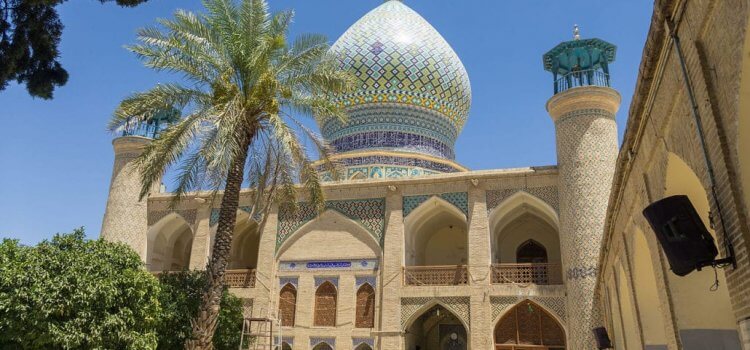Mirror Hall
The Mirror Hall and Salam Hall were built concurrently in 1874 to safeguard the Peacock Throne and the Imperial Throne.
The Mirror Hall and Salam Hall were built concurrently in 1874 to safeguard the Peacock Throne and the Imperial Throne. Abdul Hassan Mernār-bashi, also known as Sani’ al-Molk, had worked on the design of the hall in close cooperation with the then construction minister Mirza Yahyä Khan Moatamed At-Molk. On completion, renowned painter Kamal Al-Molk started working on his famous painting of the Mirror Hall. Incidentally, some jewels from the peacock Throne were stolen, thus putting the painter under suspicion and prolonging his work by five years.
Aaj (Ivory) Hall
Aaj is a Turkish word for “hunger” and the hall where the king’s guests were served food has, thus, become known as Aaj Hall. A note of caution, nonetheless, seems necessary here. In Persian, the word for ivory has exactly the same pronunciation as the word for hunger in Turkish, namely Aaj, and since there is a pair of elephant tusks in this hall, a gift to Mohammad Reza Pahlavi from the government of India, many Iranian visitors call the Aaj Hall the Ivory Hall.
Jameh Mosque of Isfahan
The construction of Jameh Mosque in Isfahan last a millennium.
Jameh mosque of isfahan is one of the oldest mosque in iran.
It begins with Arab-style, and ends with a 4 Iwans plan, decoration from the simple brick-works to finely stylized mosaic patterns, the mosque has more things to say about the history of the city; its neighborhood with Jewish district and adjacent to Grand Bazar can offer much more attractions for the travelers in its surrounding.
Khaju Bridge
If you come to Isfahan and ask people about the tourist attractions in and around the city, you will surely be recommended to visit Khaju Bridge
The Only Bridge Decorated with Haft-Rangi Tiles in Iran
If you come to Isfahan and ask people about the tourist attractions in and around the city, you will surely be recommended to visit Khaju Bridge over and over again. But why?
Well, Khaju Bridge is a multi-purpose bridge built by the order of Safavid king, Shah Abbas II, about 350 years ago. This old but invincible bridge has won the heart of people of Isfahan for several different reasons. First of all, its beauty is exemplary, being the only bridge decorated with haft-Rangi tiles in Iran. From afar, it lies in front of you like a half-drown, charming Persian girl. Standing in one of its vaulted niches, it seems as if the bridge magically directs your eyes toward the most beautiful scenes in Isfahan.
Also, it is filled with positive vibe, energizing and mesmerizing people for hundreds of years. From the time of Shah Abbas II, Khaju bridge has been a place of celebrations, public meetings, public concerts and, generally speaking, a refuge from the burden of everyday life.
Now, let’s delve a bit more into architecture and history to appreciate as much as possible the beauties of Khaju Bridge.
The History of Khaju Bridge
Years before the Safavids choosing Isfahan as the seat of their power (at the beginning of 17th century), there was a bridge on the eastern bank of Zayandeh-Rood River, connecting the city to the road which led to the city of Shiraz. This 15th bridge was built by the order of Hasan Pasha or Hasan Beik, a Timurid governor, and so was known as Hasan Abad Bridge.
But about 200 hundred years later, the Safavid king Shah Abbas II decided to build a totally new bridge over the foundations of Hasan Abad Bridge. So, architects, masons and construction workers rolled their sleeves up and built a bridge which matched the burning desires and cravings of the king.
The author of the book “Ghesas al-Khaqani” (Kings’ Tales) tells the story of the inauguration of the bridge as follows: in the year 1650, after Nowruz (Persian New Year) vacations, Shah Abbas II ordered the inauguration of the bridge. Accordingly, the bridge was decorated, covered with flowers and lighted with numerous lamps. In addition, each one of its rooms was decorated by a certain dignitary. And, in this way, Khaju Bridge was opened to the public.
However, you should know that the bridge was first known as Pol-e Shahi (or Royal Bridge). Then, it became famous as Khaju Bridge. But, what does Khaju mean?
Khaju Bridge? What does Khaoo mean?
The word Khaju is derived from Khajeh, a title used for courtiers and those close to the royal family. Now, since these courtiers were living in a neighborhood close to the Royal Bridge, the bridge also came to be known as Khaju, although with a bit of phonological change.
The Architecture of Khaju Bridge
Khaju Bridge is 133 m long, 12 m wide and includes 23 arches. is a double-decker bridge. The upper storey includes a main passageway which was used by caravans and two covered corridors, on both right and left sides, for pedestrians. The lower part of the bridge was used only by pedestrians, as a rendezvous for friendly meetings and a center of recreation.
As mentioned before, Khaju Bridge served different function and purposes. Firstly, it was used as a dam to regulate the flow of water of the Zayandeh-rud. When the 21 lower sluices were blocked by wooden panels fitted into stone grooves, the level of water behind this man-made dam increased substantially. The surplus water gathered by this engineering trick was used to fill the underground reservoirs and to irrigate the gardens built along the banks of the river. Also, by closing sluice gates, an artificial lake was formed on the Western side of the bridge at the time of festivals. In this way, the river welcomed the many boats which sailed through it during various celebrations. Fireworks, and their reflection in the water, also enhanced the spectacle.
Now, lets go to the upper storey. As we have mentioned before, the false-arches on the inner side of the bridge are decorated with haft-rangi tiles, a unique feature not enjoyed by any other bridge in Iran. In the middle of the western and eastern sides of the bridge, there are two pavilions known as Shah-Neshin. Each one of these Shah-Neshins is comprised of a large room overlooking three balconies. All of these rooms and balconies are decorated with murals from the Qajar period, painted over those from the 17th century Safavid era.
Looking down on the stone foundations and the flowing water from these rooms gives one the impression of being on a boat sailing through the river. During a flood, the conical-shaped stone structures on the lower and upper storeys helped water pass through the bridge, and thus prevented any damage to the bridge itself.
Pasargadae
Pasargadae, the city that hosts the tomb of Cyrus II, the great founder of the Achaemenid dynasty.
The site was not destroyed like Persepolis after the conquest of Alexander the Great. But its gradual abandonment meant that the stones of the palaces served as building materials for the inhabitants of the surrounding villages.
Only the tomb of Cyrus II was spared from destruction.
Alexandre paid homage to his remains during his visit to the city. The Muslim attackers respected the burial place of Solomon’s mother, the Prophet, which is there according to the local legends.
Archaeological excavations have brought to light the water canals over most of the site, which shows the existence of a large garden, a Royal Garden. These are the oldest Persian gardens, which served as a model for the famous Iranian gardens, “Pairi-Faeza” origin of the word paradise.
From the entrance to the site, you can see the famous tomb, enthroned in the middle of an esplanade, a double-roofed building on a stepped plinth. Some shuttles take you to the end of the site to visit the palaces, which are in deplorable condition today. There is a cubic tower of which only one side remains, built according to the same architecture as the Kaabeh-Zartosht in Naghshe Rostam.
At the “Entrance Palace” , on the sides of a door, a half-man, half-god figure with various symbols is represented. Some historians take it for a representation of Cyrus, without any certainty.
Naghshe-Rostam
Naghshe-Rostam, literally the image of Rostam, is the necropolis of the Kings of ancient Persia
Naghshe-Rostam, literally the image of Rostam, is the necropolis of the Kings of ancient Persia. The site was named by the locals over the Sassanid bas-reliefs evoking the story of a hero in the Book of Kings, Shahnameh of Ferdowsi.
The rock shelters the burials of four Achaemenid kings, all of them are cruciform. In front of the reliefs, there is a building in the shape of a cube, called the Kaabeh-Zartosht. Its function remains unknown until now. Perhaps it was a temporary tomb or a fire temple.
Below the entrance to the four tombs carved into the rock are several bas-reliefs. The most importants are the one that Shapour is appearing on horseback, holding the hand of a Roman emperor Valerian and the other who is kneeling is the Emperor Philippe the Arab, the first one is captured and the other is paying the ransom demanded to regain his freedom.
Two equestrian scenes showing the victories of the Sassanid kings against their Roman rivals. And further on, we can see the representation of the investiture of Ardeshir, the father of Shapour, receiving the ribboned diadem directly from Ahuramazda, the supreme god of the cult of Zoroaster, symbolizing and affirming the legitimacy of the rule of the Sassanids.
The Zoroastrian religion became politicized from this point on, and priests played a predominant role on the political scene.
Persepolis
Persepolis is the most majestic city that the Achaemenid kings have built
Persepolis is the most majestic city that the Achaemenid kings have built. Started by the order of Darius, 520 BC, the rock had to be raised to find the extent necessary for its construction and to fit out the palaces and halls of various names and functions.
Architects and craftsmen from different regions are engaged in the work to create an artistic symbiosis representing all the people forming part of the empire and subject to the undisputed power of the Achaemenid rulers.
The heart of the site is a courtroom called Apadana. This is the courtroom where the representatives of the nations were received. They were on their way to Persepolis on New Year’s Eve, bringing their gifts to the Emperor. The representation of a procession of guests has been brought to light on the stairs of the Apadana.
Two tombs were built on the rock, behinde of the site, belonging to the kings of this Achaemenid dynasty.
The city succumbs to the sacking and the raging fire of Macedonian soldiers in 333 BC. The radiance of a lavish and unparalleled period was thus extinguished, consumed by this fire.
Madrasa Khan
The Khan Madrasa (theological school) is a peaceful 17th-century Koranic school open to non-Muslim travelers thanks to the tolerant atmosphere Special to Shiraz.
The Khan Madrasa (theological school) is a peaceful 17th-century Koranic school open to non-Muslim travelers thanks to the tolerant atmosphere Special to Shiraz.
A four-Ivan plan and an interior courtyard surrounded by student cells on a double arch structure. The current decoration dates back to the 19th century. Moula -Sadra, the famous philosopher of the Safavid era, taught in this school.
In Koranic schools, apart from theology and Koranic sciences, students learn gnostics and jurisprudence, sharia law, and a preface of Classic philosophy and Platonism besides Islamic philosophy.
Madrasa seems not to be fully active, but you always find some smiling mullah in the courtyard to discuss a subject and ask some questions.
Narenjestan Ghavam
Narenjestan Ghavam (the Orange orchard, Narenj is actually the root for the orange in European languages)
Narenjestan Ghavam (the Orange orchard, Narenj is actually the root for the orange in European languages), the house of Ghavam, governor of Shiraz in the 19th century, was originally the outer part of a residential complex Whose interior, the residence of Zinatol-Molk, interconnected with each other.
We recognize the plan of a garden and the rooms located on the north side that recently transformed into a museum.
Since the 1960s the university of Shiraz has been in charge of the management.
The house is particularly known for its decorations including paintings (the drawings of Glolo-Morgh, the flower, and the bird), marquetry, mirror works, the tiles, and the bas-reliefs whose designs were taken in part from ancient Persia.
Ali-Ebne Hamzeh
The mausoleums normally house the graves of the descendants of
Shiite Imams
The mausoleum of Ali-Ebne Hamzeh
The mausoleums normally house the graves of the descendants of
Shiite Imams. In Shiism the cult of the dead is very present.
Towards the beginning of the 9th century the nephew of Imam Reza, the 8th Imam was martyred and buried in a modest building.
The presence of the Shiites, being in the minority at the time, was not tolerated and they were pursued and persecuted by the agents of Abassiid caliph.
The building was rebuilt under the Safavids around the 17th century.
The current building is very recent, the courtyard is covered with tombstones. Those who can afford it offer themselves a grave near a saint.
The interior is covered with mirror mosaics which is a kind of decoration normally reserved for mausoleums and holy places.
The entry of non-Muslims into the mausoleum is possible, but the wearing of the veil for women is compulsory. A welcome visit service for foreign visitors is offered free of charge.
Eram Garden
Eram Garden in Shiraz was originally the palatial residence of a chief of the Qashqai tribe, a turkish-speaking nomad from the Fars region.
Eram Botanical Garden
Eram Garden in Shiraz was originally the palatial residence of a chief of the Qashqai tribe, a turkish-speaking nomad from the Fars region. It is now a property of Shiraz university and its botanical research center.
A pavilion decorated with painted tiles with various designs (motifs).
On the pediment of the facade, we find the representation of the king of the 19th century, Naseredin-Shah, on horseback.
The two other scenes refer to legends, that of Joseph, son of Jacob trapped by the temptation of women, and that of Solomon and the Queen of Sheba giving audience to animals, both of which are famous and popular Quranic stories matching the dreamy ambient of the garden. Streams leave from the large pool in front of the pavilion to irrigate the entire garden.
Take the time to stroll in the garden with its exotic plants and admire the famous cypress trees, the most beautiful of Shiraz, a symbol of feminine beauty in Persian poetry.
A morning visit is recommended to get the best light.

